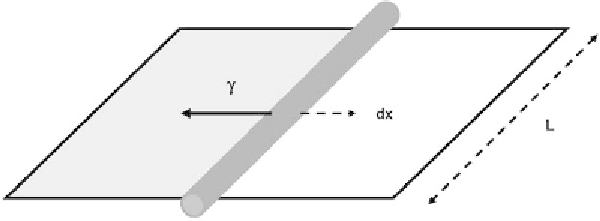Biomedical Engineering Reference
In-Depth Information
Figure 3.21
A tube placed on a rigid frame whose the left part is occupied by a soap film requires
a force to be displaced towards the right; this force opposed the surface tension that tends to bring
the tube to the left.
where
g
LG
,
g
SG
,
g
SL
are, respectively, the liquid-gas, solid-gas, and solid liquid sur-
face tensions. This relation is called Young's law and is very useful to understanding
the behavior of a drop. It especially shows that the contact angle depends on the
surface tensions of the three constituents. For a microdrop on a solid, the contact
angle is given by the relation
æ
γ γ
-
ö
SG
SL
(3.25)
θ
=
arccos
ç
÷
è
γ
ø
LG
In experimental situations when we deal with real biological liquids, one
observes unexpected changes in the contact angle with time. This is just because
biological liquids are inhomogeneous and can deposit a layer of chemical molecules
on the solid wall, thus progressively changing the value of the tension
g
SL
, and con-
sequently the value of
q
, as stated by Young's law.
Young's law can be more rigorously derived from free energy minimization. The
change of free energy due to a change in droplet size can be written as [11]
)
= + + = - +
(3.26)
where the
A
is are the surface areas and
q
is the contact angle. At mechanical equi-
librium
dE
= 0 and
dE
γ
dA
γ
dA
γ
dA
(
γ γ γ
cos
θ
dA
SL
SL
SG
SG
LG
LG
SL
SG
LG
SL
γ γ γ
-
+
cos
θ
=
0
(3.27)
SL
SG
LG
Equation (3.27) is the same as (3.24).
Figure 3.22
Schematic of the forces at the triple contact line.




